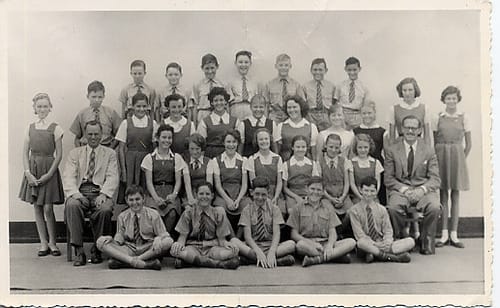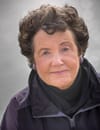Que Que Junior School Class of 1958

Back Row: Robby Fletcher, Clive Menhennick, Victor Crowther, Allan Bull, Godfrey Opperman, Norman ?, William Bueck, Henry Gerber. Third Row standing: Gillan Lyon, ?, Gywneth LLoyd, Gail Fowler, Marilyn Gaskell, Anna Naude, Elizabeth Gillham, Ann Christinson, Melody Hannaford, Wendy Allen. 2nd Row sitting Mr. Clelland, Betty Botha, Sheryl Poupart, Allison Smith, Gail Owen, Diana Hirsch, Jennifer Sinclair, Lynn Jelks, Mr. Barker the Headmaster. Front row: Paul Harper, Carl ?, Jeremy Bailey, Thomas Trotter, Roger ?.
Que Que Junior School Class of 1958
My schoolmates are scattered all over the globe. I’ve often envied my American friends that gather annually for school and college reunions.
Que Que Junior School Standard 5A Class of 1958
Que Que Junior School was built not in the thick of things but out on the edge of town, next to the new government hospital. Both institutions had huge grounds so one could hardly say they were neighbors.
There were three rows of classrooms with the headmaster’s office situated in the middle of one of them. Behind were the hostels, one for boys and one for girls. Weekly boarders came from the surrounding farms, cattle ranches of up to thirty thousand acres, maize and tobacco farms. Gold was what had brought the pioneers to Southern Rhodesia in 1890 but by the mid 1950’s gold leaf tobacco exports were more than twice gold exports.
The Naudes, the Fowlers, and the Sinclairs were farming families. The Sinclair’s house had been built on the edge of the Bembezaan River as a retreat for King George VI and Queen Elizabeth’s Royal tour in 1947. It had a hundred steps down from the front door to the bank of the river and had a magnificent Gone with the Wind staircase. But the king was too ill to avail himself of it. The Fletchers had an egg farm and their lanky son Robby was home-schooled until Standard 5, a rare exception to the boarding school rule.
Around Que Que there were recorded 295 gold ‘small workings’ and some children boarded at the school like Allan Bull. But most of the day-scholars were from the The Globe and Phoenix Mine that was the foundation of the town pegged in 1894 and established in 1900. The Menhinicks, the Bothas, the Owens, the Christenson’s, were all mineworkers of one sort or another while Mr. Allen was the accountant. Mr. Smith ran the Que Que Stores Globe and Phoenix native concession store and of course Dr. Hirsch was the mine doctor. The Lyons owned an insurance agency and Mrs. Lyon grew her own flowers on their farm and owned a florist shop. Mr. Gillham worked at the steelworks and Mrs. Gillham, a feisty Italian, owned a milk bar in Redcliff. Gangly Padre Lloyd, who seemed never to brush his hair, was the minister of St. Stephens Presbyterian Church.
Secondary industries were developing as a result of the iron and steelworks from at nearby Redcliff. William Buenk joined us in Standard 4. He was not Afrikaans, like a number of others in our class, but straight from Holland. He wore clogs to school. What a ribbing he received! Unlike America that prizes individualism, we were a cruel lot and conformist. We wore uniforms to school.
Our school teacher was Mr. Clelland, fresh from Hastings, England. Instead of learning about the Matabele Wars of 1893 and 1896, which were really exciting, we learned about William the Conquer and the Battle of Hastings in 1066. He let us know in no uncertain terms that it was far better to be British than a colonial and never let us forget it. He screwed up his eyes and his buck teeth protruded from fleshy lips. We often wondered why he’d ever ventured out to the middle of nowhere.
He set us all up with pen friends there and monitored our every word of correspondence. He had set ideas about the King’s English too, and did his best to improve our elocution. He thought we did a deplorable job of covering our text and exercise books and taught us how to do it properly with new brown paper and envelope corners like hospital beds. My mother insisted cut up brown paper bags were good enough and this was quite an unnecessary expense and busy-work.
But Mr. Clelland’s greatest challenge was Jennifer Sinclair and me. We cried when we could not do our sums. This was a great source of consternation for him. My brother, David, was skipping a class, but he needed to skip another two to join me at my school desk. I cribbed off my best friend Wendy Allen, who was top of the class every year, but when it came to quiz time, Jennifer and I were the last ones standing because we couldn’t come up with any answers.
Mr. Barker was our tall and handsome headmaster. I got to know him well when Padre Mullet of St. Luke’s Anglican Church was temporarily replaced. His replacement preached that the Jews killed Jesus. I abruptly dropped my regular Sunday school attendance. I was excused our twice-weekly compulsory denominational religious classes at school and ran errands for Mr. Baker instead.
I’d love to know what happened to my classmates.
Past due time to acknowledge my support team: sons Andrew and Jonathan Davis for a brand new computer. Andrew for web design and continued IT support, brother David Hirsch for ruthless editing and lively debate and of course obliging husband Jan Polisensky for scanning and home cooked meals. Thanks too to my readers for staying the course and interacting.
